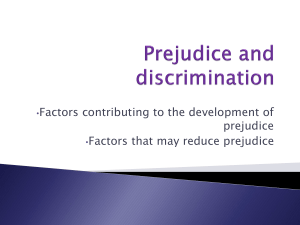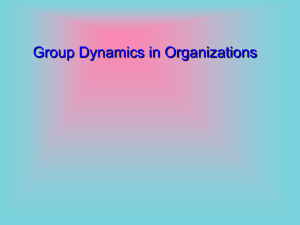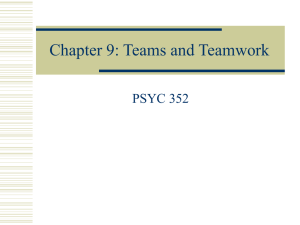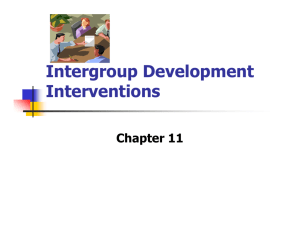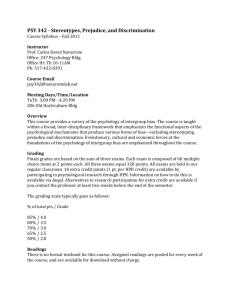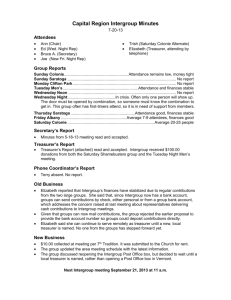GROUP DYNAMICS 2. Intragroup & Intergroup Dynamics 2.1
advertisement
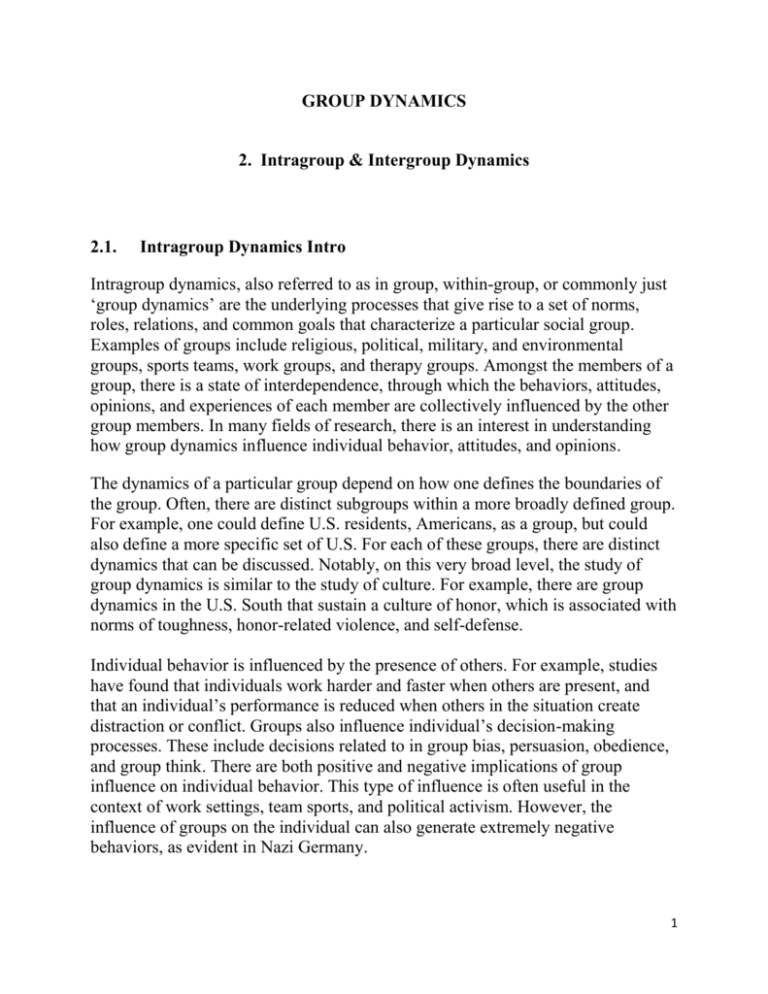
GROUP DYNAMICS 2. Intragroup & Intergroup Dynamics 2.1. Intragroup Dynamics Intro Intragroup dynamics, also referred to as in group, within-group, or commonly just ‘group dynamics’ are the underlying processes that give rise to a set of norms, roles, relations, and common goals that characterize a particular social group. Examples of groups include religious, political, military, and environmental groups, sports teams, work groups, and therapy groups. Amongst the members of a group, there is a state of interdependence, through which the behaviors, attitudes, opinions, and experiences of each member are collectively influenced by the other group members. In many fields of research, there is an interest in understanding how group dynamics influence individual behavior, attitudes, and opinions. The dynamics of a particular group depend on how one defines the boundaries of the group. Often, there are distinct subgroups within a more broadly defined group. For example, one could define U.S. residents, Americans, as a group, but could also define a more specific set of U.S. For each of these groups, there are distinct dynamics that can be discussed. Notably, on this very broad level, the study of group dynamics is similar to the study of culture. For example, there are group dynamics in the U.S. South that sustain a culture of honor, which is associated with norms of toughness, honor-related violence, and self-defense. Individual behavior is influenced by the presence of others. For example, studies have found that individuals work harder and faster when others are present, and that an individual’s performance is reduced when others in the situation create distraction or conflict. Groups also influence individual’s decision-making processes. These include decisions related to in group bias, persuasion, obedience, and group think. There are both positive and negative implications of group influence on individual behavior. This type of influence is often useful in the context of work settings, team sports, and political activism. However, the influence of groups on the individual can also generate extremely negative behaviors, as evident in Nazi Germany. 1 2.2. Group Formation, Membership, Social Identity, and Cohesion Group formation starts with a psychological bond between individuals. The social cohesion approach suggests that group formation comes out of bonds of interpersonal attraction. In contrast, the social identity approach suggests that a group starts when a collection of individuals perceive that they share some social category, and that interpersonal attraction only secondarily enhances the connection between individuals. Additionally, from the social identity approach, group formation involves both identifying with some individuals and explicitly not identifying with others. So to say, a level of psychological distinctiveness is necessary for group formation. Through interaction, individuals begin to develop group norms, roles, and attitudes which define the group, and are internalized to influence behavior. Emergent groups arise from a relatively spontaneous process of group formation. For example, in response to a natural disaster, an emergent response group may form. These groups are characterized as having no preexisting structure (e.g., group membership, allocated roles) or prior experience working together. Yet, these groups still express high levels of interdependence and coordinate knowledge, resources, and tasks. The social group is a critical source of information about individual identity. An individual’s identity or self-concept has two components: personal identity and social identity (or collective self). One’s personal identity is defined by more idiosyncratic, individual qualities and attributes. In contrast, one’s social identity is defined by his or her group membership, and the general characteristics (or prototypes) that define the group and differentiate it from others. We naturally make comparisons between our own group and other groups, but we do not necessarily make objective comparisons. Instead, we make evaluations that are self-enhancing, emphasizing the positive qualities of our own. In this way, these comparisons give us a distinct and valued social identity that benefits our selfesteem. Our social identity and group membership also satisfies a need to belong. Of course, individuals belong to multiple groups. Therefore, one’s social identity can have several, qualitatively distinct parts (for example, one’s ethnic identity, religious identity, and political identity). Optimal distinctiveness theory suggests that individuals have a desire to be similar to others, but also a desire to differentiate themselves, ultimately seeking some balance of these two desires (to obtain optimal distinctiveness). For example, one might imagine a young teenager in the United States who tries to balance these 2 desires, not wanting to be ‘just like everyone else,’ but also wanting to ‘fit in’ and be similar to others. One’s collective self may offer a balance between these two desires. That is, to be similar to others or those who you share group membership with, but also to be different from others or those who are outside of your group. In the social sciences, group cohesion refers to the processes that keep members of a social group connected. Terms such as attraction, solidarity, and morale are often used to describe group cohesion. It is thought to be one of the most important characteristics of a group, and has been linked to group performance, intergroup conflict and therapeutic change. Group cohesion, as a scientifically studied property of groups, is commonly associated with Kurt Lewin and his student, Leon Festinger. Lewin defined group cohesion as the willingness of individuals to stick together, and believed that without cohesiveness a group could not exist. As an extension of Lewin’s work, Festinger described cohesion as, the total field of forces which act on members to remain in the group. Later, this definition was modified to describe the forces acting on individual members to remain in the group, termed attraction to the group. Since then, several models for understanding the concept of group cohesion have been developed, including Albert Carron’s hierarchical model and several bidimensional models. Before Lewin and Festinger, there were, of course, descriptions of a very similar group property. For example, Emile Durkheim described two forms of solidarity (mechanical and organic), which created a sense of collective conscious and an emotion-based sense of community. 2.3. Black Sheep Effect Beliefs within the in group are based on how individuals in the group see their other members. Individuals tend to upgrade likeable in-group members and deviate from unlikeable group members, making them a separate out group. This is called the black sheep effect. A person's beliefs about the group may be changed depending upon whether they are part of the in group or out group. New members of a group must prove themselves to the full members, or “oldtimers”, to become accepted. Full members have undergone socialization and are already accepted within the group. They have more privilege than newcomers but more responsibility to help the group achieve its goals. Marginal members were once full members but lost membership because they failed to live up to the group’s expectations. They can rejoin the group if they go through re-socialization. 3 In a related study, the development of new members' stereotypes about in groups and out groups during socialization was surveyed. Results showed that the new members judged themselves as consistent with the stereotypes of their in groups, even when they had recently committed to join those groups or existed as marginal members. They also tended to judge the group as a whole in an increasingly less positive manner after they became full members. Depending on the self-esteem of an individual, members of the in group may experience different private beliefs about the group’s activities but will publicly express the opposite, that they actually share these beliefs. One member may not personally agree with something the group does, but to avoid the black sheep effect, they will publicly agree with the group and keep the private beliefs to themselves. If the person is privately self-aware, he or she is more likely to comply with the group even if they possibly have their own beliefs about the situation. In situations of hazing within fraternities and sororities on college campuses, pledges may encounter this type of situation and may outwardly comply with the tasks they are forced to do regardless of their personal feelings about the Greek institution they are joining. This is done in an effort to avoid becoming an outcast of the group. Outcasts who behave in a way that might jeopardize the group tend to be treated more harshly than the likeable ones in a group, creating a black sheep effect. Full members of a fraternity might treat the incoming new members harshly, causing the pledges to decide if they approve of the situation and if they will voice their disagreeing opinions about it. 2.4. Intergroup Dynamics Intergroup dynamics refers to the behavioral and psychological relationship between two or more groups. This includes perceptions, attitudes, opinions, and behaviors towards one’s own group, as well as those towards another group. In some cases, intergroup dynamics is pro social, positive, and beneficial (for example, when multiple research teams work together to accomplish a task or goal). In other cases, intergroup dynamics can create conflict. For example, a related study found initially positive dynamics between a clinical institution and its external authorities dramatically changed to a 'hot' and intractable conflict when authorities interfered with its embedded clinical model. Similarly, underlying the 1999 Columbine High School shooting in Littleton, Colorado, United States, intergroup dynamics played a significant role in Eric Harris’ and Dylan Klebold’s decision to kill a teacher and 14 students, including themselves. 4 2.5. Intergroup Conflicts & Reduction According to social identity theory, intergroup conflict starts with a process of comparison between individuals in one group (the in group) to those of another group (the out group). This comparison process is not unbiased and objective. Instead, it is a mechanism for enhancing one’s self-esteem. In the process of such comparisons, an individual tends to: favor the in group over the out group exaggerate and overgeneralize the differences between the in group and the out group (to enhance group distinctiveness) minimize the perception of differences between in group members remember more detailed and positive information about the in group, and more negative information about the out group Even without any intergroup interaction (as in the minimal group paradigm), individuals begin to show favoritism towards their own group, and negative reactions towards the out group. This conflict can result in prejudice, stereotypes, and discrimination. Intergroup conflict can be highly competitive, especially for social groups with a long history of conflict. In contrast, intergroup competition can sometimes be relatively harmless, particularly in situations where there is little history of conflict (for example, between students of different universities) leading to relatively harmless generalizations and mild competitive behaviors. Intergroup conflict is commonly recognized amidst racial, ethnic, religious, and political groups. The formation of intergroup conflict was investigated in a popular series of studies by Muzafer Sherif and colleagues in 1961, called the Robbers Cave Experiment. The Robbers Cave Experiment was later used to support realistic conflict theory. Other prominent theories relating to intergroup conflict include social dominance theory, and social & self-categorization theory. Outlined below are several strategies developed for reducing the tension, bias, prejudice, and conflict between social groups. These include the contact hypothesis, the jigsaw classroom, and several categorization-based strategies. Contact Hypothesis (Intergroup Contact Theory) In 1954, Gordon Allport suggested that by promoting contact between groups, prejudice can be reduced. Further, he suggested four optimal conditions for contact: equal status between the groups in the situation; common goals; 5 intergroup cooperation; and the support of authorities, law, or customs. Since then, over 500 studies have been done on prejudice reduction under variations of the contact hypothesis, and a meta-analytic review suggests overall support for its efficacy. In some cases, even without the four optimal conditions outlined by Allport, prejudice between groups can be reduced. Superordinate Identities Under the contact hypothesis, several models have been developed. A number of these models utilize a superordinate identity to reduce prejudice. That is, a more broadly defined, ‘umbrella’ group/identity that includes the groups that are in conflict. By emphasizing this superordinate identity, individuals in both subgroups can share a common social identity. For example, if there is conflict between White, Black, and Latino students in a high school, one might try to emphasize the ‘high school’ group/identity that students share to reduce conflict between the groups. Models utilizing superordinate identities include the common in group identity model, the in group projection model, the mutual intergroup differentiation model, and the in group identity model. Interdependence There are also techniques for reducing prejudice that utilize interdependence between two or more groups. That is, members across groups have to rely on one another to accomplish some goal or task. In the Robbers Cave Experiment, Sherif used this strategy to reduce conflict between groups. Elliot Aronson’s Jigsaw Classroom also uses this strategy of interdependence. In 1971, thick racial tensions were abounding in Austin, Texas. Aronson was brought in to examine the nature of this tension within schools, and to devise a strategy for reducing it. Despite strong evidence for the effectiveness of the jigsaw classroom, the strategy was not widely used arguably because of strong attitudes existing outside of the schools, which still resisted the notion that racial and ethnic minority groups are equal to Whites and, similarly, should be integrated into schools. 6
